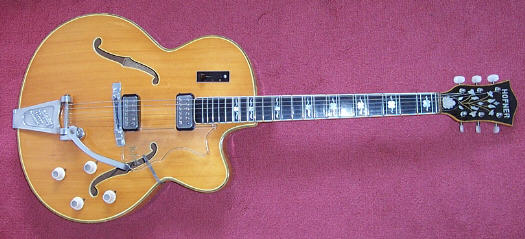

The Committee was Hofner's top of the standard range supplied to
Selmer for distribution in the UK. OK, there was the Golden Hofner, but less
than a hundred (according to serial numbers)
of these very special guitars ever made it to Britain between 1960 and 1963. You have to take the "Golden" as being the Holy Grail in Hofner collecting. The European/American market equivalent model to the Committee was the Hofner 468, with the 470S being the nearest to the Golden that anyone outside of the Selmer dealership would see.
Nevertheless, the Committee is a rather impressive guitar in its own right, with birds eye maple, flame maple, ebony, and mother of pearl in abundance. This may account for its long period of sale in the UK between 1958 (or maybe earlier prior to the Selmer period?) and 1969, during which time, competition of similar quality instruments became increasingly stronger from America.
The guitars name is derived from the committee of six top British guitarists of that time who were
(or were not) consulted by Selmer/Hofner during the design process, but who
certainly helped with the introduction of the instrument onto the 1950's UK music scene. I have heard varying accounts of whom the members of the committee
were supposed to be, but if you choose any six out of the following, you won't be far out: Bert Weedon, Ike Isaacs, Denny Wright, Roy Plummer, Jud Proctor, Frank Deniz, Jack Llewellyn, and Freddie Phillips.
The particular guitar featured here is a 1965 blonde thin line, with the small headstock; the much more impressive and desirable large headstock being discontinued in 1963. A choice of full body depth (3.25") acoustic, or full body and thin line (2") electric models was available, in blonde (natural) or brunette (sunburst) finishes.
There seems to have been a general tendency by Hofner to increase the body size
from the pre-1963 17" lower bout width to 18" on the post-63 Committees. The lavishness of the edge binding/purfling was increased at the
same time. Perhaps this was a gesture to produce an upgraded Committee (at least
in appearance) following the disappearance of the Golden Hofner from the Selmer
catalogue around 1963.
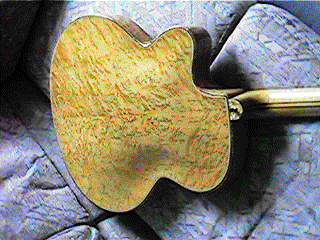
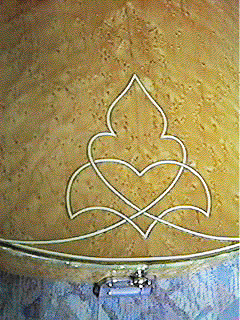
The above photos show the impressive birds eye maple veneers used on the back and sides of the guitar. There are indications that some Committees
may have had heavily flamed maple veneers, as the European/US market 468 model, but birds eye is the specification in the Selmer brochures. The body binding/purfling is eight strips thick, with the outer being imitation mother of pearl. (Very
glitzy!)
At the base of the back, three of the purfling layers are separated away from the sides to form the very attractive flower pattern shown above.
The top of the instrument is spruce laminate, which is rather a disappointment as a solid top would have been much more appropriate on such a fine guitar.
Many of the earlier instruments did in fact have solid carved tops, particularly
the acoustic versions.
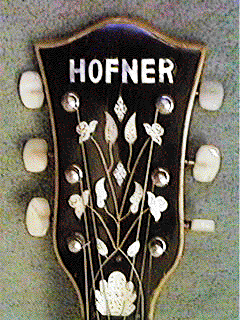
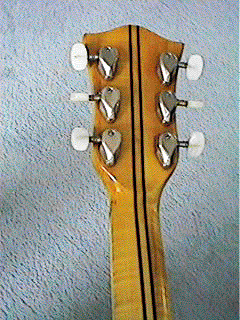
The neck is five piece maple/mahogany/beech/mahogany/maple, with a reasonable degree of flaming in the maple, and is bound with imitation mother of pearl binding. The lower section of fingerboard is separated from the guitar's body top by the usual cantilevered piece of spruce spliced into the base of the neck.
The headstock is capped with ebony veneer, into which is inlaid a mother of pearl flower pattern, this being unique in the Hofner range to the Committee and Golden.
Machine heads are single enclosed units with mother of
pearl-ish plastic buttons. The large headstock tuners on the earlier Committees were open machines, but with much more ornate buttons.
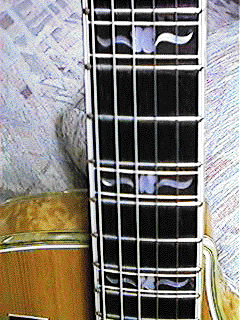
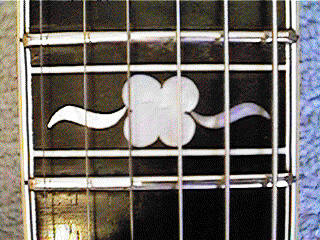
The fingerboard is of course ebony, with rather dainty mother of pearl marker details inlaid.

Two humbucking pickups are fitted. These are the "staple" type of unit introduced in 1963 as Hofner's first humbucker. The normal three-way
control of the pickups is by means of the rather clumsy looking selector switch on the instrument's top bass bout. One master volume and two tone rotary controls are fitted, together with a novel but very vague rotary Solo/Rhythm control. This combination works well in practice, but the white knobs, in my opinion, look cheap and out of place on such a visually stunning instrument. Come back the classic Hofner rectangular control consul, all is forgiven!
A Bigsby vibrato unit has been fitted at some stage, presumably after the guitar left the factory, as there is still a faint depression at the base of the body where the original tailpiece had been attached. This would have been the large nickel plated escutcheon tailpiece fitted to Committees from c.1963. The earlier guitars had the Lyre type unit (as retrospectively fitted to the 1959 President featured elsewhere on this site).
The original Hofner "micromatic" bridge has of course been replaced by the
much less attractive alloy Bigsby bridge.
Selmer offered the Bigsby unit as an extra-cost
option in their catalogue. I believe that the guitars arrived in the UK fitted
with standard tailpieces, and then Selmer fitted their own Bigsbys (made under
licence in the UK) as necessary in
order to meet specific orders, prior to sending the guitars out to the retail
stores.
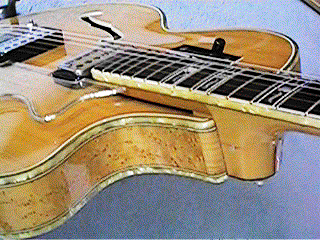
The whole appearance of the guitar has been rounded off by the clear celluloid pickguard, which is inscribed with a large gold Hofner motif.
The guitar plays well thanks to its comparatively slim neck, acceptable action, and the light gauge strings which I use on all my Hofners in order to put as little strain on the notoriously weak body/neck joints as possible. Acoustic tone and volume isn't bad considering the thin body, and the electric tone is fine if you're into jazz. It's the
appearance and built-in quality that really impresses though. If any guitar has been made as a show piece, then the Committee is it!